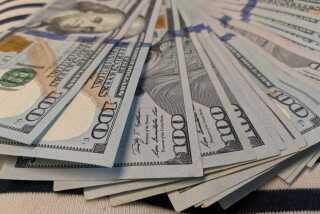Dollar Slides Again, but Fears Are Muted
- Share via
The dollar hit multiyear lows against key rival currencies Tuesday, but the only people panicked by the buck’s continuing slide may be foreign-exchange traders and Americans who hoped to vacation abroad this year.
Wall Street, long fearful that a sinking dollar could trigger wholesale dumping of U.S. assets by foreign investors, has been largely unruffled by the currency’s latest spate of weakness.
“There’s no sign of damage to the U.S.” because of the dollar’s slide, said C. Fred Bergsten, director of the Institute for International Economics in Washington.
Indeed, principal U.S. stock indexes this year have held up better than major European indexes, which was true last year as well. And yields on Treasury bonds are no higher today than in early December, when the euro began its latest surge.
In theory, the gains in the euro and other currencies at the dollar’s expense reflect global investors’ preference for foreign assets over U.S. assets -- in other words, a bet against the U.S. economy. That would be expected to put downward pressure on U.S. stock prices and upward pressure on interest rates.
What’s more, as the dollar falls it cuts the value of foreigners’ U.S. holdings. Fear of further devaluation because of a downward dollar spiral could spur more foreigners to bail out.
But many experts believe the dollar’s latest weakness has been driven primarily by currency traders who are taking a short-term view of markets and whose main concern is the threat of a U.S.-Iraq war.
“Currency traders aren’t focused on economic data. They’re looking at geopolitical risks,” said Jay Bryson, economist at Wachovia Securities in Charlotte, N.C.
The 2003 outlook for the European economy is substantially poorer than the outlook for the U.S., said Sung Won Sohn, economist at Wells Fargo in Minneapolis. That would argue for a weaker euro, he said, because currencies should reflect economic fundamentals.
But many European traders and investors “believe America could get bogged down in a Vietnam-style war in Iraq,” Sohn said. That is helping to drive demand for some euro-denominated assets as “safe haven” investments while the war threat looms, he said.
The euro’s value in New York surged to $1.072 on Tuesday, up from $1.067 on Friday and the highest since 1999. The dollar hit a four-year low against the Swiss franc. But the buck strengthened slightly against the yen.
Despite the euro’s robust gains in recent weeks, a Bloomberg News index of 500 blue-chip European stocks is down nearly 2% year to date. By contrast, the U.S. Standard & Poor’s 500 index is up 0.9%.
Net foreign purchases of U.S. stocks have declined sharply since 2000, according to Federal Reserve data. That may have deepened the long bear market.
But even if foreigners are inclined to continue deferring purchases or to sell U.S. stocks now, their influence on the market could be modest, according to Goldman Sachs & Co.
As of the third quarter of 2002, foreigners held 11% of the total value of U.S. stocks, Goldman said in a recent report. If foreigners stay away, it “will not have a notable negative effect” on the equity market, Goldman contended.
In the bond market, meanwhile, the dollar has been helped as Asian investors have stepped up purchases of U.S. government securities over the last year, even as European interest has waned.
Many experts say U.S. investors should be focused on the benefits of a lower dollar. Most important, it makes American exports less expensive for foreign buyers, which could lift U.S. firms’ sales and profit.
Some experts argue that the dollar’s fall is overdue -- and that the only problem for the U.S. economy would be if the currency’s decline ends soon.
Bergsten said a weaker dollar is the logical way to put a dent in the nation’s huge foreign trade deficit, by boosting exports while curbing Americans’ appetite for imports (a falling dollar makes imports more expensive).
He argued that the dollar still is 10% overvalued compared to where it needs to be to shrink the trade deficit in the long run.
More to Read
Inside the business of entertainment
The Wide Shot brings you news, analysis and insights on everything from streaming wars to production — and what it all means for the future.
You may occasionally receive promotional content from the Los Angeles Times.










